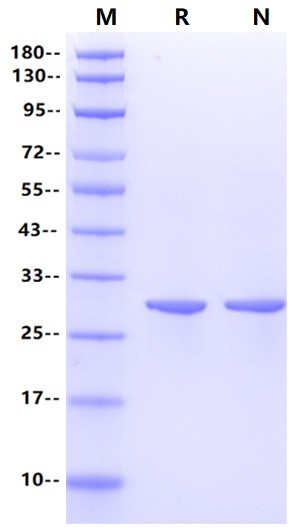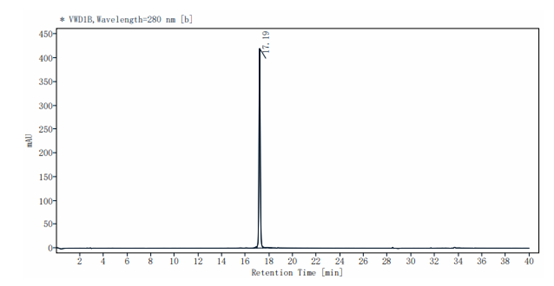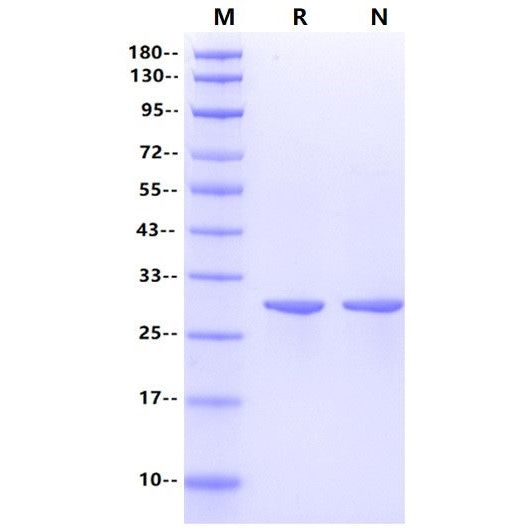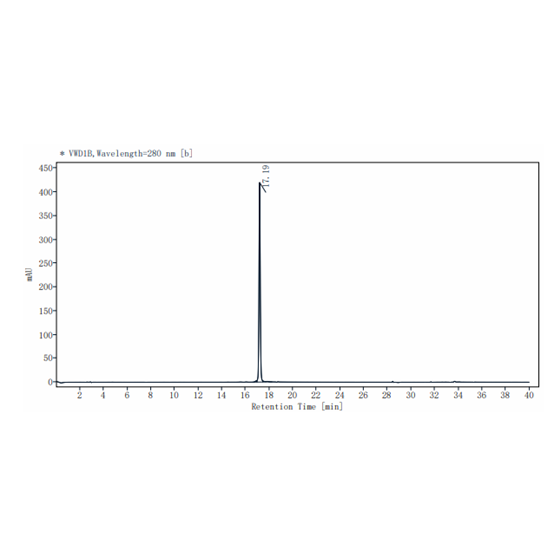Product Details
Product Details
Product Specification
| Species | Human |
| Antigen | USP11 |
| Synonyms | HX1,Deubiquitinating enzyme 11, Ubiquitin carboxyl-terminal hydrolase 11,Ubiquitin specific peptidase 11,Ubiquitin specific protease 11 |
| Accession | P51784 |
| Amino Acid Sequence | Asp67-Glu300, with N-terminal 8*His HHHHHHHHDREPQHEELPGLDSQWRQIENGESGRERPLRAGESWFLVEKHWYKQWEAYVQGGDQDSSTFPGCINNATLFQDEINWRLKEGLVEGEDYVLLPAAAWHYLVSWYGLEHGQPPIERKVIELPNIQKVEVYPVELLLVRHNDLGKSHTVQFSHTDSIGLVLRTARERFLVEPQEDTRLWAKNSEGSLDRLYDTHITVLDAALETGQLIIMETRKKDGTWPSAQLHVMNNNMSEEDE |
| Expression System | E.coli |
| Molecular Weight | 28kDa (Reducing) |
| Purity | >95% by SDS-PAGE&HPLC |
| Endotoxin | <0.1EU/μg |
| Conjugation | Unconjugated |
| Tag | His Tag |
| Physical Appearance | Lyophilized Powder |
| Storage Buffer | PBS, pH7.4 |
| Reconstitution | Reconstitute at 0.1-1 mg/ml according to the size in ultrapure water after rapid centrifugation. |
| Stability & Storage | 12 months from date of receipt, -20 to -70 °C as supplied; 6 months, -20 to -70 °C under sterile conditions after reconstitution; 1 week, 2 to 8 °C under sterile conditions after reconstitution; Please avoid repeated freeze-thaw cycles. |
| Reference | 1. Haruko Ideguchi, et al. (2002) C Structural and functional characterization of the USP11 deubiquitinating enzyme, which interacts with the RanGTP-associated protein RanBPM. Biochem J. 1;367(Pt 1):87-95. |
Background
USP11 is also named as UHX1 and belongs to the peptidase C19 family. It is a deubiquitinating enzyme that controls many intracellular processes, including cell cycle progression, transcriptional activation, and signal transduction. USP11 as a novel regulator of Mgl-1 and it requires RanBPM to regulate proteasomal degradation of Mgl-1. USP11 showed deubiquitinating activity and stabilized Mgl-1 protein. However, USP11-mediated Mgl-1 stabilization was inhibited in RanBPM-knockdown cells. Furthermore, in the cancer cell migration, the regulation of Mgl-1 by USP11 required RanBPM expression. In addition, an in vivo study revealed that depletion of USP11 leads to tumor formation. Taken together, the results indicated that USP11 functions as a tumor suppressor through the regulation of Mgl-1 protein degradation via RanBPM. USP11 may be a ubiquitous protein in various human tissues. By immunofluorescence assay, USP11 primarily was localized in the nucleus of non-dividing cells, suggesting an association between USP11 and RanBPM in the nucleus. Furthermore, the association between USP11 and RanBPM in vivo was confirmed not only by yeast two-hybrid assay but also by co-immunoprecipitation assays using exogenously expressed USP11 and RanBPM.
Picture
Picture
SDS-PAGE

RP-HPLC





